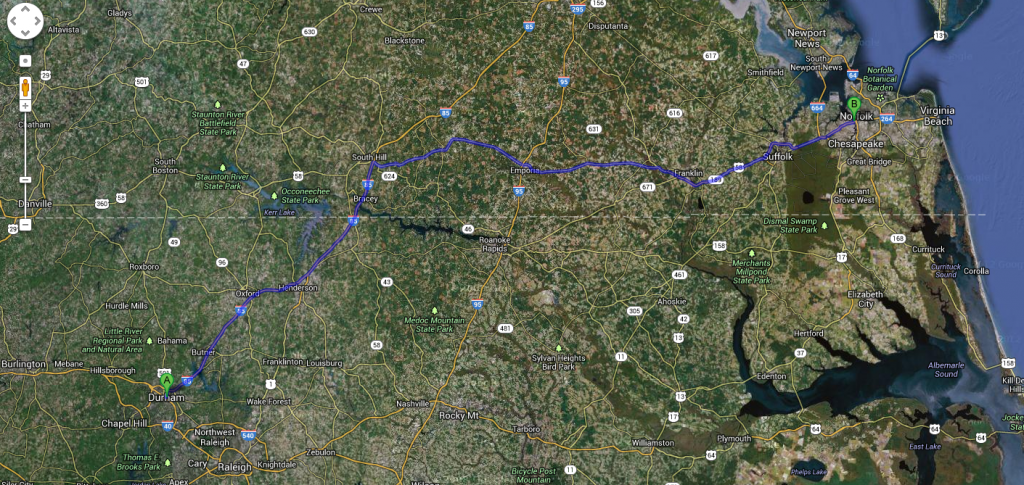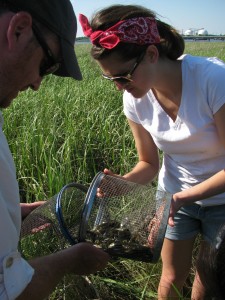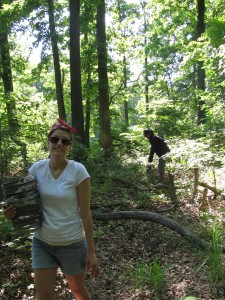Last Thursday, May 30th, a group from the Superfund Research Center made the drive to Portsmouth, Virginia with a full day planned.  The crew included Dr. Bryan Clark (Postdoctoral Associate), Gretchen Kroeger (Project Coordinator with the Research Translation Core), Liting Chen (a new REU student working in Dr. Di Giulio’s lab), and myself (Savannah Volkoff, also a new REU student working with the Research Translation Core). We had a lot of goals for this particular trip, including:
The crew included Dr. Bryan Clark (Postdoctoral Associate), Gretchen Kroeger (Project Coordinator with the Research Translation Core), Liting Chen (a new REU student working in Dr. Di Giulio’s lab), and myself (Savannah Volkoff, also a new REU student working with the Research Translation Core). We had a lot of goals for this particular trip, including:
- meet with Joe Rieger from the Elizabeth River Project,
- tour Paradise Creek Nature Park, a former contaminated site turned conservation park, and
- gather fish for lab work.
The six hours spent in the car round trip was also an opportunity for us to get to know one another better, restore a relationship with Michael Jackson, and enjoy a few Sonic milkshakes.
So why meet with the Elizabeth River Project?
For starters, one of our research projects (Project 3) focuses on a Superfund site (Atlantic Wood Industries) and other PAH-contaminated sites located on the Elizabeth River and we should be communicating with others working on the river. Another reason is that the Elizabeth River Project (ERP) is an amazing non-profit, grassroots organization. The group has had an important presence on the Elizabeth River since it first brought attention to the state of river back in 1993. Since then, ERP has built relationships with local industries and businesses, as well as community members who live alongside or near the river, in order to raise awareness about river conditions and establish a cooperative approach to improving river health.
ERP is also the driving force behind multiple remediation projects and runs summer camps and seminars to educate Virginians about the condition of the local Elizabeth River. In fact, the Elizabeth River Project is responsible for such outstanding work, that the organization received one of the EPA’s first mid-Atlantic Environmental Achievement Awards. We got to see ERP’s hard work firsthand, when Joe took us to visit Paradise Creek Nature Park. The park is situated just south of the Atlantic Wood Superfund site. Based on the restoration, including 11 acres of wetlands, native wildflowers and grasses, and multiple walking trails which allow you to look out to Paradise Creek and enjoy the area which is now teeming with wildlife, you’d never have guessed that this area was also once an industrial wasteland. This park now provides the local community with land to exercise, socialize, and interact with nature.
Joe is a tremendous source of knowledge about the Elizabeth River and meeting with him opened our eyes to the many opportunities to collaborate with the Elizabeth River Project and combine their efforts with the research coming out of Project 3. Not only does is the ERP working to restore river health through partnerships, but it also serves a resource for the community to learn about the river, wetlands restoration, local wildlife, and environmental stewardship. While there will be a lot of ways for our research to contribute to the work of ERP, two examples are communicating our research in the ERP’s updated State of the River report as well as designing an activity station on their Learning Barge, which is a floating educational center for K-12 students, equipped with composting toilets and both fresh and saltwater wetlands.
We ended our long day with successful fish collection.

We collected both male and female Fundulus fish (also called Atlantic killifish or mummichogs) from five different sites along the Elizabeth River, each site varying in contamination levels. We set traps, with hotdogs as bait, at each site and then rotated with trap collection and loot examination. The fish will be used by graduate students researching the effects of PAHs in sediments on Fundulus (see our page on Project 3 for more info!).
Everyone had a great time on this excursion! I had never really done field work before and hiking to the sampling sites was sometimes challenging. I came home with Elizabeth River muck between my toes, deer fly bites on my neck and arms, and scratches on my legs. Permeating from my body and clothes were the sweet scents of sweat, Fundulus,and hot dogs. And I loved it!



